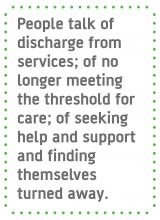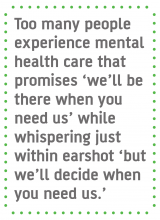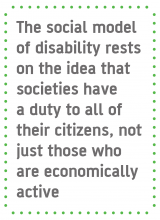
By Mark Brown
Part 1: If your mental health difficulty is always there, ongoing personalised care and support in mental health isn’t
The issue of long-term care and support for people who experience the kinds of mental distress and ill-health that don’t go away has become one of the more bafflingly contentious issues within mental health. Not every mental health difficulty goes away.

Not every challenge that mental health difficulty creates can be ‘cured’. Some people have mental health difficulties that don’t go away. That reality is not a failure of treatment; it’s a statement of fact. Some of us are lucky enough to have mental health difficulties that are episodic. They come and go. When they’re there, they’re there and when they aren’t we don’t notice them as
being anything different to the everyday experience of being us. This isn’t true for everyone. For some of us, everyday life is struggle against the things that happen in our heads. Times are not divided so much by illness and health but by being better and being worse. Sometimes what makes a given period better is support or treatment. Sometimes it’s the absence of that treatment or support that makes things worse. Some challenges never go away. Some only go away because support or treatment mitigates their effects.
It might seem obvious that if someone has ongoing difficulties they should be able to access ongoing support, no questions asked. You might take as your example chronic physical health conditions, where someone requires ongoing support and treatment to manage their symptoms. You might take as your example the lives of Disabled people and the way help and support removes what disables them. You might assume that having a mental health difficulty that stays with you and makes some things more difficult for you than other people would be an obvious case for the provision of such personalised support. Coming to mental health from the outside you’d expect it, but you’d be wrong.
What I and others hear listening to people who live with long-term distress and mental ill-health is that, somehow, somewhere along the way, in the UK we’ve managed to find ourselves in a situation where the idea of people needing long-term support for mental health difficulty has somehow fallen out of vogue.

The idea of care in mental health – in the sense of an individual’s consistent requirement for support, guidance and assistance from others – has been crowded out by ideas about resilience, independence, empowerment and recovery which have shifted the focus of services from ongoing provision to episodic intervention. Every day I hear and read people talking of discharge from services; of no longer meeting the threshold for care; of seeking help and support based on how well they understand themselves and finding themselves turned away. The idea people might rely upon support throughout their life remains anathema within many currently accepted ideas about what should be ‘done’ about mental distress and ill-health.
If you have experienced mental health difficulties for twenty, thirty, forty years, it seems reasonable to accept that it’s unlikely that you will one day sink into a larval stage and then, after a period of cocooned seclusion, hatch into a glorious neurotypical butterfly and fly unfettered into the sky of self reliance and ‘normality’. When mental health difficulty is present in your life almost continually, learning to accept what you experience can be like sharing a home with a difficult family member, or surviving in ice or desert or on a harsh mountainside where every single change in circumstances could bring about catastrophe. While you are in control of what you can control, you are still at the mercy of things that are beyond your ability alone to resolve. You get to know intimately this interior country of yourself, the paths that lead to crisis and where the places of safety and sustenance may be found.

When looking for reasons why ongoing care and support isn’t being provided to more people with mental health difficulties, many will cry out that lack of money is the problem. But, as I’ve said elsewhere, lack of money is not a natural fact. It’s the result of decisions made by people. The question is why do we accept this ‘fact’ to be true? What is the logic that has led us to a place where people cannot get help they need on an ongoing basis even when we acknowledge their needs are ongoing? Historic neglect of the needs and wishes of people with long-term mental health needs is certainly a factor, but the web of ideas that have interacted with each other over the last half century are more complex than that. In relation to long-term care and mental health, the idea that it couldn’t be provided is often intimately mixed with arguments about why it shouldn’t be provided.
Too many people experience mental health care that promises ‘we’ll be there when you need us’ while whispering just within earshot ‘but we’ll decide when you need us.’ How have we reached a point where the ongoing support dreamed of by people who experience difficulties across their life seems like just that: a silly dream in the face of a variety of arguments for why something else completely should happen?
Part 2: Chronic conditions, personalised care, ongoing support – but not for mental health?
Accepting that you will never be fully free of things that cause you difficulties is not a defeat, especially where an understanding of how they cause difficulties is part of finding ways of living better with them. And that means resources.
Social care could provide some of the ongoing long-term care and support for people with long-term distress and mental ill-health, even if mental health is currently very far down the social care list of priorities. Health for Care, a coalition of 15 organisations convened by the NHS Confederation, issued an open letter to Prime Minister Theresa May calling on her government to properly fund social care. Without care, they argue, health gets worse for those who need ongoing support but don’t get it.
Accepting that you will never be fully free of things that cause you difficulties is not a defeat
Broadly speaking, the NHS in England is waking up to the realisation that its job is less as an episodic treatment dispenser than it is a partner in people’s ongoing health, recognising that what keeps people well is not the same thing as what helps them when they are ill. We broadly accept that people should be able to live as long as possible with the right support and care; even if we remain politically conflicted overall about spending money raised through taxation to achieve that. Despite all that, people with long-term severe mental illnesses still on average die 15 to 20 years earlier than they might otherwise.
According to the Kings Fund about 15 million people in England have a long-term condition. Long-term conditions or chronic diseases are conditions for which there is currently no cure, and which are managed with drugs and other treatment. According to the Department for Work and Pensions, 19% of working age people in the UK (and 22% of the overall population) have a disability. Disability charity Scope claim that this amounts to 13.9 million people of a UK population of 66.02 million.
The NHS is waking up to the realisation that its job is less as an episodic treatment dispenser than it is a partner in people’s ongoing health
In October 2018 The All Party Parliamentary Group on Mental Health published “Progress of the Five Year Forward View for Mental Health: On the road to parity” observing: “Mental health treatment is most effective when the person seeking help feels involved and empowered to make decisions about their care so, where possible, service users should also have a say in the type of treatment they receive.” The chapter also quotes a carer of someone with a diagnosis of schizophrenia, explaining how far mental health feels from other forms of care: “I’ve just supported my partner through cancer care and it’s really highlighted the difference between severe physical health and severe mental health issues…the cancer pathway was clear, well-organised, and there was always someone to call no matter the time. The mental healthcare system is completely different.”
On January 7th NHS England published The NHS Long Term Plan. It sets out the roadmap for the next ten years in the life of the NHS, and by extension, for the health of the people of England. One of its milestones is that by 2023/24, 370,000 adults and older adults with severe mental illness will have “greater choice and control over their care” and support to “live well in their communities” made possible by “new and integrated models of primary and community mental health care.” This declaration follows the final recommendations of the independent review of the Mental Health Act 1983 “Modernising the Mental Health Act: Increasing choice, reducing compulsion” in 2018, which recommended a new approach to care planning for people who have been detained under the Mental Health Act.
‘The cancer pathway was clear, well-organised, and there was always someone to call no matter the time. The mental healthcare system is completely different.’
On January 31st 2019, NHS England published ‘Universal Personalised Care: implementing the Comprehensive Model’; described as document intending to “set out our ambitions for the delivery of personalised care.” The document was drawn up in collaboration with a range of organisations; though interestingly, none from mental health.
Universal Personalised Care sets out six components of a comprehensive model for personalised care:
- Shared decision making
- Personalised care and support planning
- Enabling choice, including legal rights to choice
- Social prescribing and community-based support
- Supported self-management
- Personal health budgets and integrated personal budgets.
The document doesn’t mention long-term severe mental health difficulty, although work is underway by The National Collaborating Centre for Mental Health to explore this. Looking at the components of personalised care, they look very much like the kind of comprehensive support for which many who live with long-term severe mental health difficulties are hoping. Care; support; shared decision making; community-based supports; personal budgets: all of these are partial answers to the diversity of challenges people face and the impact they have upon people’s lives. But it’s not coming for mental health, at least not in such explicit terms.
Part 3: What’s so bad about long-term care and support in mental health anyway?
If personalised and ongoing care makes so much sense for chronic conditions, what’s the problem with mental health being seen the same way? Why are those asking for it seen as being at odds with what’s considered ‘best’ for them? What makes it so hard to accept that severe mental ill-health or distress can be an ongoing experience that requires ongoing care and support?
When people think about long-term care and support for the kinds of mental health difficulties that don’t go away, they are mainly thinking about the kind of support that might fall under social care. This is less about treatment and more about ongoing support: both to address ongoing needs that don’t go away, and to find ways to work around them or through them. This is mainly informed, whether people realise it or not, by thinking similar to the social model of disability.
The social model of disability rests in part on a Marxist analysis of capitalist society, which holds that because disabled people have been seen as contributing no labour, they are seen as a surplus of needs to be managed, and not as contributors. Society being arranged around money and labour, disabled people have been excluded: from the means of making money and through the structuring of society around the needs of those contributing, but also from the means to find ways of supporting themselves. The social model of disability rests on the idea that societies have a duty to all of their citizens, not just those who are economically active.
The social model of disability grew from a desire to escape from institutionalisation and limited opportunities. Without personalised support, care and adjustment backed up by law and taxation, the logic of ‘care’ for Disabled people was one of maintenance and cost minimisation.

To be Disabled, politically, is to be excluded from the rights and entitlements others take for granted because you are different from others. The answer is that society has a duty to remove as many of the barriers to Disabled people as possible so that they can take up all of the social goods and civic responsibilities that others would expect. In practice this means the provision of care, adjustment and support that, as much as possible, level the playing field. In this understanding, care and support are provided not as a benevolent act of charity but as a fundamental recognition of rights. It’s hard to extricate the idea of the rights of Disabled people from the notion of a State being able to provide or to intervene in the ways that social and economic processes happen, especially where the idea of adaptation and adjustment of existing circumstances is required. Someone must pay somewhere for the support, care and adjustment that disabled people require to benefit from the opportunities and rights others take for granted.
The wider world of mental health has not always been on great terms with the social model of Disability, leading to conflict around whether long-term mental health difficulty is truly comparable to physical or intellectual disability. The Equalities Act 2010 which rolled together a number of previous equalities laws states that:
“A person (P) has a disability if—
(a) P has a physical or mental impairment, and
(b) the impairment has a substantial and long-term adverse effect on P’s ability to carry out normal day-to-day activities”
It also defines discrimination arising from disability as:
“A person (A) discriminates against a disabled person (B) if—
(a) A treats B unfavourably because of something arising in consequence of B’s disability, and
(b) A cannot show that the treatment is a proportionate means of achieving a legitimate aim.”
UK law is currently aligned with EU law, which itself is still struggling to produce a clear and unambiguous definition of Disability, leaning toward Disability being recognised by its effects rather than its causes but still relying upon case law rather than watertight definitions. One such can of worms was opened in 2014 when a European Court of Justice ruling suggested that the work limitations experienced by an obese man who worked as a childminder should be covered by disability legislation. When looked at dispassionately, this should be an obvious case. However, questions about culture, self-responsibility, the example it set and whether it was ‘right’ to endorse obesity made the case a focus of fervent debate. Making changes would be ‘too expensive’. It would send the ‘wrong message’. It would make a mockery of those with disabilities who were ‘born with them’. Through their own actions people could choose to ‘make themselves disabled’. For some this was seen as an affront to ‘honest British common sense’ and an example of EU ridiculousness in line with straight bananas. In many ways the idea of long-term mental health difficulty as disability requiring long-term care falls into a similar pattern of kneejerk, gut feeling responses.
People with long-term severe mental health needs are not missing out on what they need to lead their lives because nothing is happening. Something is happening. There isn’t a void, there’s a mismatch. Mental health treatment and support is being provided; it just isn’t being provided to enough people in a way that recognises mental distress and mental ill-health as a chronic condition or disability.
Long term mental health need has always been viewed with suspicion. We like neat categories. Long term mental health need, in common with other invisible or variable disabilities, confuses our desire to be able to make definitive judgements. Long term mental health need is not consistent. It fluctuates over time. Sometimes it is more disabling than others. Sometimes, with the right support or treatment in place or in the right conditions or situations it is not disabling at all. Long term mental health need may not be apparent to others; especially where people avoid circumstances and situations where their mental health difficulties are most obvious or most likely to be seen.
Historically in mental health there has been a competency paradox: have insight and competency in managing your particular problems and you will be seen as not being in need of help and support. Lack such skill and experience in knowing yourself and what ails you and you will not be considered competent to express your preference. Make demands for what you need, on the basis you know yourself best, and you might be unlucky enough to find yourself perceived as someone who is just about coping. And just about coping is seen as stability, and stability is seen as re-admittance to the world of people who do not require ongoing care.
Further than this is the idea, contrary to a social model of Disability view, that to rely upon others for support would somehow take away individual agency and make people unable to ‘look after themselves’. If we just gave people with long-term needs what they want, the argument goes, then they would never learn how to do things for themselves. Within a social model of disability, the claiming of resources and the political admission that needing them is not a personal failing means that the demand for resources is key. Empowerment is advocating for and claiming those resources because your needs are different to others but your entitlement to life is the same. In long-term mental health the inverse is true: the logic we have arrived at suggests empowerment is found in needing the least amount of support and resources. Literally, once you have found your empowerment, you will not need assistance. Change is a matter of personal motivation and encouragement, not of control over resources.
The idea that empowerment might be a benevolent gift results from the idea that being in the position of marginalisation or being on the receiving end of inequalities is a psychological state rather than a material one. Lack of access to resources is a cumulative experience: the longer that lack persists, the greater the effect on your life. Not having food enough for one day feels awful; but never having enough food eventually leads to death. The experience of missing opportunities for education or for building a safe home life aren’t just felt through a snapshot comparison with others at any given point across your life. The effect of past inequalities are felt as a growing deviation in opportunities and personal competencies that piles one loss upon another upon another. Inequality is the systemic failure to distribute any form of resource or social good in ways where the outcome is equal between all.
Empowerment in mental health often mashes up the idea of self-determination; where people have power over their own lives; with self-reliance; where people draw upon their own skills and abilities. The spectre that hangs over the idea of empowerment is, in this cosmology, its evil twin: dependency. In this view, an empowered individual or community does not rely upon others to do things for them. Give a man a fish, the worn-out slogan goes, and he will eat for a day; teach a man to fish and he will eat forever. Recovery in mental health is seen as synonymous with competency and competency is a learned quality; not a functional one.
When we tell a community that ‘it’s not what’s wrong; it’s what’s strong’ without acknowledging inequality it can feel like what is being said is ‘what are you going to do to sort your own problems out?’ The measure of empowerment in this view is not the degree of command over resources that an individual or community has, but the lack of reliance on the resources of others. Considering power is the literal extent to which it is possible to command or induce others to do things, it is odd that empowerment for those regarded to be marginalised, as many who live with long-term distress and mental ill-health are, should be so at odds. No one suggests that a Prime Minister is dependent because they don’t put the bins out themselves, or don’t rig up their own telephone lines or plan their own travel. When we are talking about men and fishes we could equally argue: rich men never catch their own fish and get to decide to have something other than fish for dinner.
When we tell a community that ‘it’s not what’s wrong; it’s what’s strong’ without acknowledging inequality it can feel like what is being said is ‘what are you going to do to sort your own problems out?’
Rich, privileged communities might look like ‘they stand on their own two feet’, but that’s easy to do when you have the power to demand and receive everything you need. For people with long-term mental health needs, it’s only a mixture of large and small, political and practical, professional and personal, that will get us where we want or need to be.
Recovery in mental health was once the rallying cry for mental health activists but is viewed by some with suspicion. To be ‘recovered’ in the understanding of activist groups like Recovery in the Bin is to no longer be entitled to support; even when it was support in the first place that made living a viable life possible.
Part 4: Where do ideas about mental health and long-term care come from?
Mental health has a history. Mental health and distress happen in an ever-changing context of real world conditions. The maintenance of mental health, as with all human endeavours, has a history. No idea or practice or structure is born without parents and ancestors. We often fall into the trap of seeing treating and supporting people with mental health difficulties as something that exists outside of history; as if the way things are now is how they always have been and always will be, rather than being the result of complicated interactions between ideas and material conditions over time.
In mental health, what seems eternal is defined by being a reaction to what came before. There is the comforting idea that research and practice and knowledge builds upon itself in an unbroken line of progress, each year pushing back the boundaries into fresher, safer and more fulfilling lands. The reality is more mundane and less directional; politics, economics and social ideas combine in ways that are less like a game of dominoes, each step laid neatly end to end, and more like a game of chess where every move changes the shape of every move that follows.
Politics, economics and social ideas combine in ways that are like a game of chess where every move changes the shape of every move that follows
It’s tempting to the see the world of mental health as a set of binaries with a pendulum that swings between their two poles depending on the time period about which we’re thinking.
Some of these binaries include:
- Medical model / social model
- Dependence / recovery
- Services / community
- Compulsion / autonomy
- Professional / service user
- Academic knowledge / lived experience knowledge
- Passivity / empowerment
- Prescription / choice
- Science / nature
- Biology / biography
Most of these binaries have an implicit ‘good pole’, which we would recognise as progress and an implicit ‘bad pole’ which represents the opposite. When we think of making change happen we think of it as pushing the pendulum further from the bad and closer to the good. But there’s a problem with that. Our binaries of ‘good and bad’ or ‘progress and regression’ are not perfect platonic forms. They exist in times, places and circumstances. All of these binaries were formed by people thinking specific things about specific current events. Each shift is trying to solve the problems of the past by the time it arrives. None of these binaries exist in isolation or seclusion from wider social, economic or political ideas or circumstances. They all act upon events at the same time and change conditions as they do so. None of these binaries are firewalled from each other. Pushing one toward a desired ‘good’ pole can push others further toward the ‘bad’ one. What seems like an eternal binary was created to reflect a certain reality, defined by certain events and ideas in relation to certain problems or challenges. Any such binary is influenced by previous binaries and the current circumstances that way of thinking has created.
Rather than having a number of different binary scales with which we can measure progress along from ‘good’ to ‘bad’, the situation of people who live with long-term distress and mental ill-health is a single pendulum that is pushed and pulled by all of these binaries overlapping, shifting it closer to some poles and further away from others. Each binary as an isolated idea might tell you that the experience of people with mental difficulties has gotten better in relation to a particular idea of ‘better’ or ‘worse’ based on one narrow area of focus. But none of those binaries alone can tell you whether things have, overall, gotten better or worse for those people. The best measure of that is the overall aggregate voice of those people, but this is a group voice that is seldom listened to very carefully, if at all.
Our binaries of ‘good and bad’ or ‘progress and regression’ are not perfect platonic forms.
Most of our ideas about how mental health should be regarded and fitted into life post-date the establishment of the NHS. The UK’s social security system and what it means are impossible to filter from the history of thinking about mental health in the country. Debates rage in mental health circles about whether diagnosis of long-term difficulties is useful and whether such long-term intrinsic difficulties should be recognised as illnesses or would be better understood as differences. The question remains: is the aim to receive support because you have different needs or to be considered in the same way as everyone else? Where you stand upon this often comes from a variety of different experiences and ideas. And what is happening now is a result of what people thought best in previous decades.
Writing in his 1997 edition of ‘Closing the Asylum: The Mental Patient in Modern Society’, Peter Bareham captures many of the binary tensions in mental health care at time where it was as yet unclear the direction public policy and attitudes would take going into the New Labour years. It was a time where the voice of mental health service users or survivors was a stronger force than it had ever been, but that voice was based on the experience of long-term mental ill-health and distress in the 1970s and 80s. In chapter titled ‘Broken and Flawed Individuals’ Bareham writes about people with diagnosis of schizophrenia throwing off the position ascribed to them by the ‘sick role’; quoting an “ex-mental patient” telling a researcher “You are not your illness! Find another role besides mental patient!”
Bareham quotes favourably a then-recent Michael Ignatieff article which captures the cry for liberation from the Welfare State: “The citizenship ideals of the post-war liberals and social democrats stressed the passive quality of entitlements at the expense of the active equality of participation. The entitled never felt empowered, because the empowerment would have infringed the prerogatives of the managers of the welfare state… Only someone who has not actually been on the receiving end of the welfare state would dare call it an instance of civic altruism at work.” He quotes an interviewee of Ignatieff’s as saying “Simon… described how demoralizing it felt to be part of the mental-patient system, ‘you’re sort of tied to the strings of the hospital, the apron strings of the hospital, you’re being treated like a child…’”
The best measure is the overall aggregate voice of those people, but this is a group voice that is seldom listened to very carefully, if at all
“From Anger to Action” produced by Mental Health Media in 1992 is a training video which serves as a time capsule of ideas held by people with mental health difficulties about wishing to escape from poor, patronising or coercive mental health services and to create lived experience-led alternatives. Various people in the video (which is worth a watch to see how much has and hasn’t changed in 27 years) talk about wanting an alternative to the mental health system, shifting the binary. One person says: “When I left the mental health system I knew there were loads of people who were stuck in it who could also have been leaving it if they’d had the opportunities I’ve had. One thing I’d like to say to mental health workers is those people that you might think are never going to get better, always going to be dependent on drugs, always dependent on social security, always struggling in and out of hospital – don’t make those hopeless assumptions about them because once you start making those assumptions then they’re more likely to become true. The truth is that those people could be having very good lives at some point in the future.” Another says: “Most of my problems had been either as a result of medication or as a result of being told I was ill or not worthy or not quite right.”
The experience of limiting expectations, and the cultural belief that those who experienced severe mental health difficulties were somehow irretrievable and could only be managed and ‘looked after’, led a previous generation of activists to desire freedom from the limiting assumptions of mental health professionals. These activists desired autonomy and an escape from medical control of their lives, proclaiming that they were people the same as anyone else, even if different. The demand was in many ways a demand for the end of the exclusion of people who experience long-term distress and mental ill-health, a desire to come in from the cold and not to be set aside as different.
What people advocating for a particular form of freedom couldn’t see in the 1990s was how the world would change around their ideas. We would like to think that this messy world of compromise and power and received ideas is intimately shaped by evidence and lived experience, but the reality is more complicated. The narratives that stick about any given state of affairs are the ones that fit the tenor of their times. What wins is sometimes the thing that most people in a country want; but it’s also often the thing that most people will tolerate and which some people with power most want to happen.
The demand was for the end of the exclusion of people who experience long-term distress and mental ill-health, a desire to come in from the cold and not to be set aside as different.
People with lived experience in mental health who have been around the block a bit often talk about ideas created by people with lived experience being co-opted or betrayed if and when they are adopted by ‘the system’. What begins as a liberatory idea becomes, when put into action in combination with other ideas, a far less positive one. This is often portrayed as the idea have been changed in its journey into the system, as if it were possible for ideas in practice to remain pure and uncontaminated. What is more likely to happen is an example of unintended consequences. An idea might have one intended or desired effect, along one binary between good and bad, but when thrown into the stew of overlapping agendas, desires, objectives and duties it becomes an ingredient, not a main course. What was a pure solution to a specific problem facing some people becomes something different when it is adopted as part of something that includes lots of other ideas and existing practices.
The lived reality of experiencing distress or mental ill-health is not a constant from generation to generation. The research practice gap in mental health is measured in decades, not years. The research policy gap around the things that affect the lives of people living with long-term distress might be as close as one conversation with a minister or so far that not even our most powerful telescopes might span the distance. People who experience long-term distress and mental ill-health have been the victims of people with good intentions advocating for changes that were affected over such long time-scales that when they finally arrived, they didn’t mean what they had when they were formulated, because the world had moved on. Even good ideas aren’t insulated from causing bad effects. What people advocating freedom from services based on analysis of power couldn’t have foreseen in the 1990s was how the pendulum would shift away from wanting to provide those kinds of ongoing services as a matter of course, toward a country where any form of long-term need was viewed with suspicion. What they didn’t anticipate was that people would be receptive to that shift, but only because it endorsed and sat well with other shifts in policy, practice and ideas.
Part 5: Freedom from services: It was meant to be great but it’s horrible
People currently living with long-term distress and mental ill-health in the UK are living in a situation where well-meaning ideas of ending exclusion have mixed with the withdrawal of financial and social/medical long-term care to create a logic that seems eager to define them as deserving of no particular special forms of support. After being subject to the policy and cultural concerns of its time, what was a liberation from the constraints of a previous era becomes the problem to be solved in the next.
The ideas that shape the treatment and support of mental illness in the UK have been influenced by the existence of a nation security system and a national health service. The 21st century so far has seen a massive redefinition of both. Many people with long-term mental health needs are now poorer, talk more of reduced services and support, and feel further from what they need than ever.
Well-meaning ideas of ending exclusion have mixed with the withdrawal of financial and social/medical long-term care to create a logic that defines them as deserving of no particular special forms of support
In March last year I wrote about a demonstration at the annual New Savoy Partnership Psychological Therapies conference, a two day event discussing psychological therapies and the NHS. Outside the venue demonstrators distributed a flyer that read ‘Therapeutic support for people not bullshit ‘health and work’ and phoney evidence’ while “banners proclaimed ‘Welfare reforms are cuts that kill’; ‘Equality is the best therapy’ and ‘IAPT fails us all.’”
The protest took aim at spending on the Improving Access to Psychological Therapies Programme, which offers low-intensity, limited term support and therapy to people derived from Cognitive Behavioural Therapy. As I wrote: “Money spent on prevention arguably reduces costs overall but does not reduce costs to an individual for whom problems have not been prevented. People with long-term mental health difficulties, the kind that do not go away but which can be mitigated with support and professional involvement are caught in the middle between prevention and acute hospital care. Caught, in fact, in exactly the space where longer term therapy and support might be considered most useful.”
The first term of the New Labour government was concerned very strongly with the idea of social exclusion and the idea that some in society were further away from being able to participate in civic life. Part of the reasoning was that Conservative policies of the previous 12 years had instilled a sense of hopelessness in communities, meaning people had become unhappy, unwell and had experiences low levels of subjective wellbeing. Lack of jobs and public spending, the logic went, had left people ‘stuck on benefits’.
Many people with long-term mental health needs are now poorer, talk more of reduced services and support, and feel further from what they need than ever
During this period, mental health services became more recovery-oriented, looking to minimise the amount of time people with mental health difficulties spent ‘excluded’ from community and economic life. At the same time, a growing political movement in the UK were become uncomfortable with the amount that was spent on benefits and the idea that people were not ‘helping themselves’. In a speech in June 2002 then Prime Minister Tony Blair set out an agenda for change: “Those with health problems or a disability of some kind also face barriers to work… Of course there will always be some people who may never realistically be able to work – and they must have security and inclusion… But many people with a health problem or disability could and do want to work – yet don’t. It is a scandal that 2.7m people on incapacity and disability benefits are written off, left to drift into long-term incapacity and unemployment. Five months into their claim for incapacity benefit, over 90% of people expect to return to work. But in practice, 44% will still be on IB six months later; and of those fewer than one in five will be working five years after that.”
The initial 2006 report produced by Richard Layard and colleagues at Centre for Economic Performance at the London School of Economics that began the foundation of IAPT argued an economic case for extending psychological therapies. They argued that such an expansion would pay for itself in increased productivity and reduce social security and health spending.
Discussing the pre-history of IAPT and shifts in policy I wrote: “In 2008, Dame Carol Black’s review of the health of the working age population suggested that people who become unwell should be helped as early as possible with view to their remaining in the workforce and that those on benefits should return to work as soon as possible. Helping people get jobs and keep jobs was considered to be a prime target for reducing the spiralling of the effects and costs of mental health difficulty… The introduction of benefit sanctions, which are considered by some to disproportionately affect those experiencing mental health difficulties, created a feeling that people with mental health difficulties were being set up for a fall. At the same time as local charitable and statutory support withered away and the employment market stagnated, rhetoric about benefits scroungers divided the world into strivers and skivvers.”
As local charitable and statutory support withered away and the employment market stagnated, rhetoric about benefits scroungers divided the world into strivers and skivvers
During this period the mental health anti-stigma campaign Time to Change was formulated and launched, initially on a very strong platform of minimising the perceived difference between those who experience mental health difficulties and those who do not. And then, with the advent of the global financial crisis and the formation of the Coalition government in 2010, public spending first flatlined and then actually shrunk drastically. Changes to social security benefits that massively reduced eligibility for many people with long-term mental health difficulties also brought in increased conditionality leading to a feared sanctions regime. Community assets began to disappear and mental health and social care services, never the best funded, began to creak alarmingly.
There has been some movement in the last two years to increase funding for mental health overall, but people with the kinds of mental health difficulty that do not go away remain marooned between hospital and prevention. The casualty of improvement for some in mental health has been the loss of the idea that some people require support and care to live the best life possible and know that their difficulties are chronic not episodic. Paradoxically, these people have seen their lives and options contract as their stories have become more difficult to find a home for beyond social media, at a time when the overall volume of discussion about mental health has been deafening in comparison to previous periods.
People with the kinds of mental health difficulty that do not go away remain marooned between hospital and prevention
Responses to this crisis have been conflicted, with many accepting the communities themselves might provide the answer to the needs of those who live with long-term distress and mental ill-health. In a 2018 paper ‘The Impact of Austerity on Mental Health Service Provision: A UK Perspective’, Ian Cummins discusses Newlin and co-workers’ (2015) systematic review of fourteen social network approaches. Their paper found four broad domains of potential approaches to mental health:
“Asset based approaches: These approaches focused on developing the capacities of individuals and communities. This group included, for example, art therapy or similar activities. The importance of such activities lies not just in the activity itself but the mutual support and safety that a group can provide. These approaches help to improve self-esteem and confidence.
Social Skills development: Three of the group interventions focused on social skills development. The most commonly taught skills included social problem solving, life skills, listening and communication and activity planning. They have to be viewed in the broadest social and cultural terms.
Goal setting: This approach was often based on a case management model. The relationship between the participants and workers was identified as the main driver in the improvement in social networks.
Peer support: The broader advantages of peer support are well documented. The small nature of the sample makes it difficult to reach any firm conclusions.”
The assumption is that people do not want services and ongoing care, a thread that has continued since at least the 1990s
None of these are a direct substitute for professional care and support delivered under the control of a person experiencing long-term distress and mental ill-health. The assumption is that people do not want services and ongoing care, a thread that has continued since at least the 1990s. It seems that it is impossible to conceive of a present where people receive professional care and support based upon their expressed long-term mental health needs. The idea that people might want or need ongoing care and support continues to be an under-explored area in a marketplace of ideas that values novelty and posturing. People love to watch their own particular binary for signs of progress while missing the reality that the overlap of all of those binary ideas has left people with long-term needs high and dry. By accident, many well meaning people have contributed to a hostile environment for people who might thrive and grow if only they could receive support, care and treatment over the course of their life. It is no coincidence that some activists see this retraction not as a liberation but as a concerted act of democide, concluding that the negative effect of the last decade of policy and practice towards those with long-term mental health needs must be a coordinated campaign of state violence.
Part 6: Talking over people who need more will guarantee they get less
Living life with an ongoing mental health difficulty is hard. Not being able to access help and support that fits your needs makes it even harder.
While some people with long-term mental health needs do see the current policy agenda as some kind of neoliberal attempt to both reduce public spending and exert social control over people like them, by no means everyone in this situation views it in these terms. While there are certainly people who were overjoyed to be left alone by mental health services and for the state to stop interfering in their lives, many more are desperate for services and support, both practical and financial, that are available, appropriate and which meet their needs.
There is an entire generation of people with long-term mental health needs who have come to maturity never having experienced the cloying and dispiriting mental health services that previous generations were keen to escape. These people wonder what life might have been like if they had actually had the ongoing support they needed.
While there are certainly people who were overjoyed for the state to stop interfering in their lives, many more are desperate for services and support, both practical and financial
According to the latest Care Quality Commission community mental health survey: “Only 43% of respondents said they had ‘definitely’ seen NHS mental health services enough for their needs in the previous 12 months. Results for this question have been declining since 2014.” The CQC remark that this ‘represents a gradual deterioration in the proportion of people feeling they can definitely access the right levels of care, with the result now below ‘expected limits’ for the first time (meaning performance has deteriorated beyond what was seen previously). The survey found that the percentage of respondents who said they had ‘definitely’ agreed on the care they would receive with someone from NHS mental health services further decreased this year to 41%.” The survey also found that younger respondents aged 18-35 “reported poorer than average experiences for the following themes: respect and dignity, access, communication, organisation, respect for patient centred values, involvement, crisis care, peer support and overall experience” and that “reported experiences for those aged 36-50 were also found to be worse than average across: respect and dignity, access, communication and overall experience.”
It still remains more attractive to many to take on a stance that speaks of liberating people from services rather than seeing ways that the provision of services might liberate people. In a lot of ways, medical observation has been replaced by legal observation. In an inversion of the logic of the previous swing of the policy pendulum, it is now mental health services who seem eager to intervene as little as possible in people’s lives, while the bodies that govern people’s entitlement to benefits are ever more eager to tell people what they should do. The interference and intervention of health professionals in the defining of someone’s future has been replaced by the observation, monitoring and prescription of non-medical bodies such as the Department of Work and Pensions. We still retain, even in politically radical circles, the idea that dependency on the labour or support of others for your mental wellbeing is undesirable and that there is nothing specific that people who live with long-term distress and mental ill-health need apart from for things to be better and friendlier. Reducing the poverty experienced by people who live with mental health difficulties is a vital component of change; but that is only the first step, not the pinnacle.
It still remains more attractive to speak of liberating people from services rather than seeing ways that the provision of services might liberate people
People with long-term experiences of distress and mental ill-health are people for whom prevention has not worked; for whom the barriers to finding a place to thrive in the world are not entirely based on attitude and self-reliance. Personalised care is not the same as care planning. Access to treatment is not the same as ongoing support. Legal recourse against discrimination is not the same as a legal right to help and ongoing care. The story of a life lived with long-term distress and mental ill-health is not the same as the story of services. Talk of the social causes of mental health difficulty is not the same as talk of what social supports and adaptations could be made to help someone live and thrive in a world where those causes are present. Recovery is not the same as being free from ongoing need. Living a life with a mental health difficulty that never goes away is a story in itself, not a subset of another. I hear stories every day from people who live each hour knowing that their life could be better, bigger, more beautiful but for the want of help that there doesn’t even seem to be a path to requesting.
People with long-term experiences of mental ill-health are people for whom prevention has not worked; for whom the barriers to finding a place to thrive in the world are not entirely based on attitude and self-reliance
Needing ongoing help and support around your mental health to be more than you can be alone is not a failing. Our talking over people who need more with our own conceptions of what’s best means they will continue to get less.
Some people have mental health difficulties that don’t go away.
These pieces are part of our writer in residence programme, and are the writer’s personal views.












